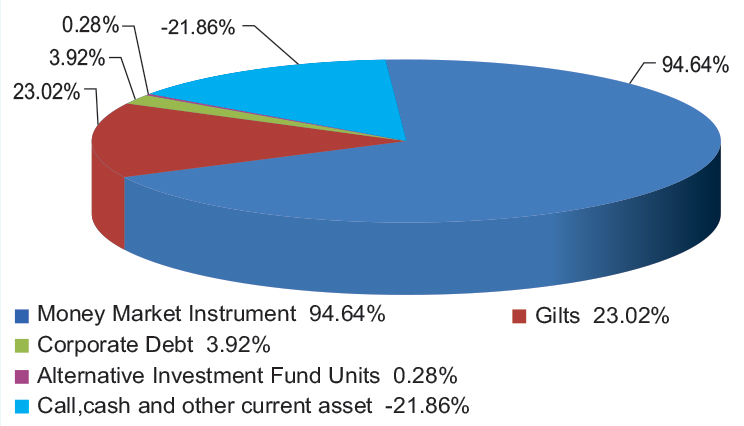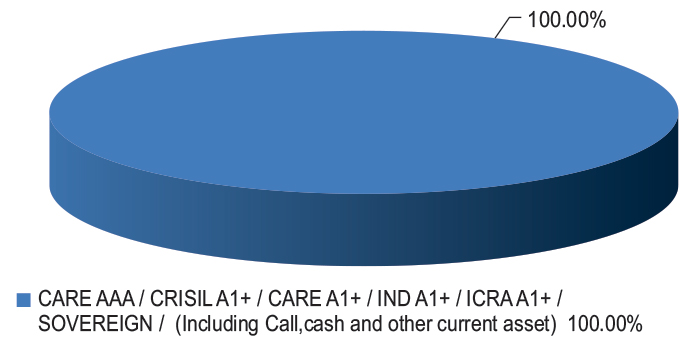

|
Franklin India Liquid Fund
As on August 29, 2025 |

 |


|
An Open-end Liquid scheme
SCHEME CATEGORY
Liquid Fund
SCHEME CHARACTERISTICS
Max Security Level Maturity of 91 days
INVESTMENT OBJECTIVE
The investment objective of the scheme is to provide current income along with high liquidity.
DATE OF ALLOTMENT:
| FILF - R Plan | April 29, 1998 |
| FILF- I Plan | June 22, 2004 |
| FILF - SI Plan | September 2, 2005 |
FUND MANAGER(S):
Pallab Roy &
Rohan Maru (w.e.f. October 10, 2024)
BENCHMARK:
NIFTY Liquid Index A-I (w.e.f. April 1, 2024)
MATURITY & YIELD
| RESIDUAL MATURITY /AVERAGE MATURITY | 0.11 Years 42 Days |
| ANNUALISED PORTFOLIO YTM# | 5.97% |
| MODIFIED DURATION | 0.11 Years 39 Days |
| MACAULAY DURATION | 0.11 Years 41 Days |
Please note that from this month onwards, we will be giving average maturity, modified duration and macaulay duration in years as well as in days.
| EXPENSE RATIO#: | EXPENSE RATIO# (DIRECT) : |
| FILF-R Plan* 0.86% | FILF SI Plan 0.13% |
| FILF-I Plan* 0.60% | |
| FILF-SI Plan 0.20% | |
| # The above ratio includes the GST on Investment Management Fees. The rates specified are the actual expenses charged as at the end of the month. | |
| MINIMUM INVESTMENT/MULTIPLES FOR NEW INVESTORS: | |
| FILF - SI Plan - WDP | Rs 25 lakh/1 |
| FILF - SI Plan - other options | Rs 10,000/1 |
Rs 500/1
| ADDITIONAL INVESTMENT/ MULTIPLES FOR EXISTING INVESTORS: | |
| FILF - SI Plan - WDP | Rs 1 lakh/1 |
| FILF - SI Plan - other options | Rs 1000/1 |
| R Plan: Regular Plan; I Plan: Institutional Plan; SI Plan - Super Institutional Plan WDP : Weekly Dividend Payout | |
| FILF - SI Plan | |||||||||||||||||
| Entry Load: Nil | |||||||||||||||||
| EXIT LOAD (for each purchase of Units) | |||||||||||||||||
| |||||||||||||||||
|
Different plans have a different expense structure *Sales suspended in Regular Plan & Institutional Plan | |||||||||||||||||
| FILF - R Plan | |
| Growth Option | Rs 5962.9235 |
| Weekly IDCW Option | Rs 1244.2967 |
| Daily IDCW Option | Rs 1509.2342 |
| FILF - I Plan | |
| Weekly IDCW Option | Rs 1054.7184 |
| Daily IDCW Option | Rs 1000.0000 |
| FILF Super Institutional Plan | |
| Growth Option | Rs 3968.8231 |
| Weekly IDCW Option | Rs 1031.0647 |
| Daily IDCW Option | Rs 1000.0000 |
| FILF - Super Institutional Plan (Direct) | |
| Growth Option | Rs 4002.1270 |
| Weekly IDCW Option | Rs 1021.4598 |
| Daily IDCW Option | Rs 1002.2720 |
| As per the addendum dated March 31, 2021, the Dividend Plan has been renamed to Income Distribution cum capital withdrawal (IDCW) Plan with effect from April 1, 2021 | |
| FUND SIZE (AUM) | |
| Month End | Rs 3139.68 Crores |
| Monthly Average | Rs 3540.86 Crores |
| Company Name | Company Ratings | Market Value (including accrued interest, if any) (Rs. in Lakhs) | % of assets | |||
| Can Fin Homes Ltd | ICRA AA+ | 10,050.38 | 3.20 | |||
| Total Corporate Debt | 10,050.38 | 3.20 | ||||
| National Bank For Agriculture & Rural Development | IND AAA | 10,694.01 | 3.41 | |||
| Total PSU/PFI Bonds | 10,694.01 | 3.41 | ||||
| Canara Bank* | CRISIL A1+ | 26,785.58 | 8.53 | |||
| National Bank For Agriculture & Rural Development* | ICRA A1+ | 24,872.08 | 7.92 | |||
| HDFC Bank Ltd* | CARE A1+ | 19,883.63 | 6.33 | |||
| Reliance Retail Ventures Ltd* | CARE A1+ | 19,735.44 | 6.29 | |||
| Indian Oil Corporation Ltd* | ICRA A1+ | 17,362.41 | 5.53 | |||
| Indian Oil Corporation Ltd* | IND A1+ | 14,988.20 | 4.77 | |||
| Indian Bank* | CRISIL A1+ | 14,919.47 | 4.75 | |||
| IIFL Finance Ltd* | CRISIL A1+ | 12,466.74 | 3.97 | |||
| Bajaj Financial Securities Ltd* | CRISIL A1+ | 11,359.31 | 3.62 | |||
| Axis Bank Ltd | CRISIL A1+ | 9,974.87 | 3.18 | |||
| Reliance Industries Ltd | CARE A1+ | 9,958.96 | 3.17 | |||
| Aditya Birla Capital Ltd | IND A1+ | 9,910.41 | 3.16 | |||
| Julius Baer Capital (India) Pvt Ltd | CRISIL A1+ | 9,908.49 | 3.16 | |||
| Axis Securities Ltd | CRISIL A1+ | 9,869.20 | 3.14 | |||
| ICICI Securities Ltd | CRISIL A1+ | 4,991.58 | 1.59 | |||
| Barclays Investments & Loans India Pvt Ltd | CRISIL A1+ | 4,978.09 | 1.59 | |||
| Godrej Properties Ltd | ICRA A1+ | 4,949.23 | 1.58 | |||
| Tata Power Co Ltd | CRISIL A1+ | 4,928.74 | 1.57 | |||
| Kotak Securities Ltd | CRISIL A1+ | 4,927.95 | 1.57 | |||
| Bharti Telecom Ltd | CRISIL A1+ | 2,491.33 | 0.79 | |||
| Total Money Market Instruments | 2,39,261.67 | 76.21 | ||||
| 91 DTB (18-SEP-2025)* | SOVEREIGN | 16,453.60 | 5.24 | |||
| 8.23% Maharashtra SDL (09-Sep-2025) | SOVEREIGN | 10,395.51 | 3.31 | |||
| 182 DTB (11-SEP-2025) | SOVEREIGN | 9,982.08 | 3.18 | |||
| 91 DTB (02-OCT-2025) | SOVEREIGN | 9,951.23 | 3.17 | |||
| 182 DTB (18-SEP-2025) | SOVEREIGN | 7,478.91 | 2.38 | |||
| 8.25% Punjab SDL (09-Sep-2025) | SOVEREIGN | 2,599.13 | 0.83 | |||
| 364 DTB (04-SEP-2025) | SOVEREIGN | 2,498.15 | 0.80 | |||
| 8.24% Tamil Nadu SDL (09-Sep-2025) | SOVEREIGN | 1,559.40 | 0.50 | |||
| 8.24% Andhra Pradesh SDL (09-Sep-2025) | SOVEREIGN | 1,559.39 | 0.50 | |||
| 8.25% Madhya Pradesh SDL (09-Sep-2025) | SOVEREIGN | 1,039.65 | 0.33 | |||
| 8.23% Gujarat SDL (09-Sep-2025) | SOVEREIGN | 1,039.55 | 0.33 | |||
| 8.17% West Bengal SDL (23-Sep-2025) | SOVEREIGN | 1,037.01 | 0.33 | |||
| 8.20% GOI 2025 (24-SEP-2025) | SOVEREIGN | 518.54 | 0.17 | |||
| Total Gilts | 66,112.15 | 21.06 | ||||
| Total Debt Holdings | 3,26,118.21 | 103.87 | ||||
| Company Name | No.of Shares | Market Value(Rs. in Lakhs) | % of Assets | |||
| Alternative Investment Fund Units | ||||||
| Corporate Debt Market Development Fund Class A2 | 6,427 | 728.14 | 0.23 | |||
| Total Alternative Investment Fund Units | 728.14 | 0.23 | ||||
| Total Holdings | 3,26,846.35 | 104.10 | ||||
| Call,cash and other current asset | -12,877.87 | -4.10 | ||||
| Total Asset | 3,13,968.48 | 100.00 | ||||
| * Top 10 holdings | ||||||
@ TREPs /Reverse Repo : -4.22%, Others (Cash/ Subscription receivable/ Redemption payable/ Receivables on sale/Payable on Purchase/ Other Receivable / Other Payable) : 0.12%
Aggregate investments by other schemes of Franklin Templeton Mutual Fund in this scheme is Rs. 355.83 Lakhs.
AUM excluding the aggregate investments by other schemes of Franklin Templeton Mutual Fund in this scheme is Rs. 3,20,334.40 Lakhs.
Average AUM excluding the aggregate investments by other schemes of Franklin Templeton Mutual Fund in this scheme is Rs. 3,59,455.69 Lakhs.
*ICRA has assigned a credit rating of (ICRA)A1+mfs to Franklin India Liquid Fund (FILF). ICRA’s mutual fund rating methodology is based on evaluating the inherent credit quality
of the funds portfolio. As a measure of the credit quality of a debt fund’s assets. ICRA uses the concept of ‘credit scores’. These scores are based on ICRA’s estimates of credit risk
associated with each exposure of the portfolio taking into account its maturity. To quantify the credit risk scores, ICRA uses its database of historical default rates for various rating
categories for various maturity buckets. The credit risk Rating incorporate ICRA’s assessment of a debt fund’s published investment objectives and policies, its management
characteristics, and the creditworthiness of its investment portfolio. ICRA reviews relevant fund information on an ongoing basis to support its published rating opinions. If the
portfolio credit score meets the benchmark of the assigned rating during the review, the rating is retained. In an event that the benchmark credit score is breached, ICRA gives a
month’s time to the debt fund manager to bring the portfolio credit score within the benchmark credit score. If the debt fund manager is able to reduce the portfolio credit score
within the benchmark credit score, the rating is retained. If the portfolio still continues to breach the benchmark credit score, the rating is revised to reflect the change in credit
quality.
CRISIL Ratings’ assessment of a rated fund’s credit quality is based on the creditworthiness of the fund’s portfolio. CRISIL Ratings has developed a credit quality matrix to assess
the aggregate credit quality of a fund’s underlying portfolio. The matrix is a set of credit factors and credit scores derived scientifically from the default and transition rates of
CRISIL Ratings’ long-term ratings. The credit factors reflect the expected default behaviour of the respective securities in the portfolio, and the expected deterioration in their
credit quality. The lower the credit factor for each security, the higher would be its inherent credit quality. The credit factors are applied to the proportion of securities held in each
rating category to arrive at the credit score for the portfolio. The rating on the fund is assigned on the basis of the fund’s total credit score. A rated fund needs to maintain, at all
times, a credit score consistent with its assigned rating. An evaluation of the portfolio investments done for the last six months indicates that Franklin India Liquid Fund has
maintained its credit score consistently. The assigned rating is valid only for 'Franklin India Liquid Fund'. The rating of CRISIL Ratings is not an opinion of the AMCs willingness or
ability to make timely payments to the investor. The rating is also not an opinion on the stability of the NAV of the Fund, which could vary with market developments.
All investments in debt funds are subject to various types of risks including credit risk, interest rate risk, liquidity risk etc. Some fixed income schemes may have a higher
concentration to securities rated below AA and therefore may be exposed to relatively higher risk of downgrade or default and the associated volatility in prices which could
impact NAV of the scheme. Credit rating issued by SEBI registered entities is an opinion of the rating agency and should not be considered as an assurance of repayment by
issuer. There is no assurance or guarantee of principal or returns in any of the mutual fund scheme.
This scheme has exposure to floating rate instruments . The duration of these instruments is linked to the interest rate reset period. The interest rate risk in a floating rate
instrument or in a fixed rate instrument hedged with derivatives is likely to be lesser than that in an equivalent maturity fixed rate instrument. Under some market circumstances
the volatility may be of an order greater than what may ordinarily be expected considering only its duration. Hence investors are recommended to consider the unadjusted
portfolio maturity of the scheme as well and exercise adequate due diligence when deciding to make their investments.

